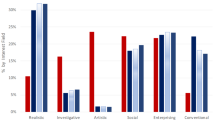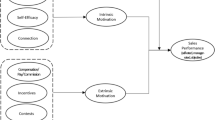Abstract
The appropriate conception of team outputs is investigated by estimating a two-output factor demand system for baseball teams, relative to which single-output models are rejected. This finding is robust to alternative approaches to testing and model choice. The factor demands are those of the symmetric generalized McFadden cost function, which has several advantages in this context. The team factor inputs are the skill characteristics of players, the prices of which are obtained hedonically. In addition to investigating one- versus two-output models, the estimation results are used to obtain demand and substitution elasticities, factor input elasticities with respect to output, cost elasticities, and measures of economies of scale and scope. Although the results support a multiproduct conception of team production, output separability is not rejected, suggesting that team outputs may sometimes be adequately treated as a production aggregate.
Similar content being viewed by others
References
Asai S (2006) Scale economies and scope economies in the Japanese broadcasting market. Inf Econ Policy 18: 321–331
Barnett WA, Geweke J, Wolfe M (1991) Seminonparametric Bayesian estimation of the asymptotically ideal production model. J Econ 49: 5–50
Baumol WJ, Panzar J, Willig R (1982) Contestable markets and the theory of industry structure. Harcourt Brace Jovanovich, San Diego
Blackorby C, Primont D, Russell RR (1977) On testing separability restrictions with flexible functional forms. J Econ 5: 195–209
Blackorby C, Russell RR (1989) Will the real elasticity of substitution please stand up? (A comparison of the Allen/Uzawa and Morishima elasticities). Am Econ Rev 79: 882–888
Cairns J (1990) The demand for professional team sports. Br Rev Econ Issues 12: 1–20
Cairns J, Jennett N, Sloane PJ (1986) The economics of professional team sports: a survey of theory and evidence. J Econ Stud 13: 3–80
Davidson R, MacKinnon JG (2004) Econometric theory and methods. Oxford University Press, New York
Davis GC, Shumway CR (1996) To tell the truth about the Morishima elasticity of substitution. Can J Agric Econ 44: 173–182
Depken CA, Grant D (2004) Multiproduct pricing in major league baseball: an empirical analysis using principle components. Working Paper 04-008, Department of Economics, University of Texas at Arlington. Econ Inq (forthcoming)
Diewert WE, Wales TJ (1987) Flexible functional forms and global curvature conditions. Econometrica 55: 43–68
Downward P, Dawson A (2000) The economics of professional team sports. Routledge, London
Ferguson DG, Jones JCH, Stewart KG (2000) Competition within a cartel: League conduct and team conduct in the market for baseball player services. Rev Econ Stat 82: 422–430
Fort RD (2006) Sports economics. Prentice-Hall, Upper Saddle River NJ
Hall RE (1973) The specification of technology with several kinds of outputs. J Political Econ 81: 878–892
Kumbhakar SC (1990) A reexamination of returns to scale, density and technical progress in U.S. airlines. South Econ J 57: 428–442
Kumbhakar SC (1994) A multiproduct symmetric generalized McFadden cost function. J Product Anal 5: 349–357
Moshini G (1992) A non-nested test of separability for flexible functional forms. Rev Econ Stat 74: 365–369
Neale W (1964) The peculiar economics of professional sport. Q J Econ 78: 1–14
Nemoto J, Goto M (2004) Technological externalities and economies of vertical integration in the electric utility industry. Int J Ind Organ 22: 67–81
Pagan AR (1984) Econometric issues in the analysis of regressions with generated regressors. Int Econ Rev 25: 221–247
Panzar J, Willig R (1977) Economies of scale in multi-output production. Q J Econ 91: 481–493
Rask K (1995) The structure of technology in Brazilian sugarcane production, 1975–87. J Appl Econ 10: 221–232
Staiger D, Stock JH (1997) Instrumental variables regression with weak instruments. Econometrica 65: 557–586
Stewart KG (2009) Nonjointness and scope economies in the multiproduct symmetric generalized McFadden cost function. J Prod Anal 32 (forthcoming)
Stewart KG, Jones JCH (1998) Hedonics and demand analysis: the implicit demand for player attributes. Econ Inq 36: 192–202
Stewart KG, Jones JCH (2005) Are sports teams multiproduct firms? Econometrics Working Paper 0513, Department of Economics, University of Victoria
Terrell D (1995) Flexibility and regularity properties of the asymptotically ideal production model. Econ Rev 14: 1–17
Vuong QH (1989) Likelihood ratio tests for model selection and non-nested hypotheses. Econometrica 57: 307–333
Author information
Authors and Affiliations
Corresponding author
Rights and permissions
About this article
Cite this article
Stewart, K.G., Jones, J.C.H. Are sports teams multiproduct firms?. Empir Econ 39, 487–514 (2010). https://doi.org/10.1007/s00181-009-0315-5
Received:
Accepted:
Published:
Issue Date:
DOI: https://doi.org/10.1007/s00181-009-0315-5




